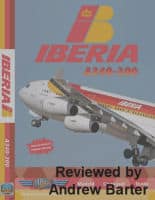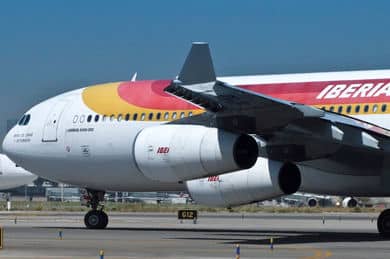
Iberia, Spain’s largest airline and the fourth largest in Europe, was founded in 1927. Their current fleet is made up of Airbus aircraft which consists of the A319, A320, A321, A340-300, and A340-600. Their active fleet of 113 aircraft mainly serves Europe and Latin America but they do have destinations all over the world using their current fleet of 35 A340’s. We will be taking a trip using JustPlane’s video of the A340-300 to Quito and Guayquil, Ecuador, from Madrid, Spain.
Madrid — Quito
The flight from Madrid to Quito starts with a quick view of the briefing including local and enroute weather and the planned route. An interesting note is that they mention one passenger who is accompanied by police. They also show some of the special maps they use for flying over the mountainous areas of the Andes which is for alternate routes in case of loss of cabin pressure. These are covered in more detail while enroute.
We are then taking to the tarmac at Madrid and we are taken through the walk around where we’ll learn some interesting things about the pitot tubes, tyres, and brakes. We are shown how to tell if a tyre is worn too much.
Back into the cockpit we see the load sheet which is very important and is used to double check the FMS data. The take-off weight (tow) is 250,000 kgs. The Take-off card is shown and we can see the V speeds and other important data. The importance of the paper card as a backup to the FCDU is stressed.
Once this is done the pilots start the checklists. Unfortunately, for the English speaking people viewing they are in Spanish only. The startup commences and we note the engines idle around 20.5% N1 once started. Here, the pilot notes a rule about waiting 10 mins for the engines to stabilize before continuing. They use the chronometer for this. While waiting we notice the pitch trim, again if you want to replicate the route in FS this will be helpful.
Before and during the taxi the camera shows each screen that the pilot is talking about so you can follow along. It’s just as well because the view outside of the cockpit during taxi is too bright to see anything. Also, noted during taxi is that they only taxi with two engines so that the outer engines do not pick up debris. They hang off the concrete taxiway due to the length of the wings. Flight simmers should note this if realism is what you are striving for.
Take-off is using 32c as the FLEX temp with the outside real temperature is 12c. The view outside during take-off is clear with a little smog but you get a nice view approaching the mountains. Real and sim pilots note the 500ft/min climb while accelerating to 250 knots and the clean config at 220 knots. They climb at 250 knots until 10,000ft AGL (Above Ground Level) not ASL. This is an important note for simmers as we’ve been often instructed that it’s Above Sea Level in user manuals. When he has a chance the pilot covers the RNAV departure for 36L. Another note for simmers is that landing lights are turned off at 12,000ft. Again, 10,000ft AGL. The initial cruise will be at FL330 and eventually going to FL350.
We learn an interesting lesson while climbing on how to detect a turbulent cloud and what they do to avoid them to give passengers a smooth ride. Once they are comfortable we are shown how they use routes across the Atlantic along with the weather to determine the optimal FL. Very good detail on oceanic crossing limitations and rules plus how they use the MCDU to request approval of their route. The pilot notes they do not use Cost Index for this route due to the weight differences along the way as fuel is burned. The view enroute is nice but as you may expect, over the Atlantic is pretty dull. Thankfully, JustPlanes doesn’t burn up time on the DVD with oceanic views.
As we get further into the flight we are shown how to use the MCDU to request a new altitude. Their request is denied. Then we get into a very detailed coverage of the instrument panel. The cameraman moves really slow at times and we almost miss the visual cue’s of the pilot’s lesson. With Airbus aircraft the throttle system is different than other aircraft and there’s a good description of the détente’s. Next the AP coverage is good but cameraman does not follow the instrument’s to see what is going on. He just looks at the pilot.
Volcano activity causes a diversion over Martinique and then Caracas while enroute. Coverage of the destination and alternate weather is explained and we begin the approach briefing. There’s no ILS approach at Quito on this flight so they have to do a challenging VOR approach in mountainous terrain. They program this into the FMC and the back-up flight plan is used for the opposite runway in case ATC gives them a runway they weren’t expecting. We have time for more information from the pilot and he explains brakes and fuel usage.
During the final landing phase the pilots select the altitude in case of a go around but do not activate it, of course. The autobrakes are set at medium for landing and disconnected before 80 knots after landing.
Quito is a big city that is really spread out. More than I expected. The approach is cloudy but you can still see some of the city. If you are a fan of old aircraft Quito has allot. You can see a F27, S340, F28, and a DC10. JustPlanes has included a nice tour  in between flights at Quito but the sound is not loud and clear so you’ll have to crank up the volume if you want to hear what is going on. You see the sign of Latitude of zero and the little gravity demo is cool, too. You’ll have to see it to understand.
Quito – Guayquil
This leg is at night so you won’t see much scenery outside the window but the city lights are visible and very striking. The pilot explains how they handle the unique hot and high take off situation at Quito. We’ll be departing on runway 35 and series of turns is required to avoid a volcano. The take-off briefing is covered in detail. Here, the cameraman watches the displays while two engines are being started. During taxi the pilot explains the difference between brakes of older aircraft and new ones.
It’s here that we see something flight simmers have discussed in forums. The taxi lights are more focused straight ahead in real life than they are in MSFS. The lights are more focused on the centerline and hardly at all to the left or right. Typically, in FS we see a triangle formed with the lights but it’s actually more of an oval shape.
We expect runway 21 approach at Guayquil. Again the checklists are read off in Spanish. Â The pilot explains how the wingspan affects their taxi at this airport.
This flight is short so the cruise level is 23,000ft at 320 knots. During approach we note the localizer captured at 183 knots and glidescope around 4,000ft. Flight simmers note that the aircraft does not capture the GS smoothly and climbs and descends a little before settling into the descent. Flaps are full on landing.
Guayquil — Madrid
This another night flight with a morning landing. I really like this part because the First Officer goes over the receiving of the aircraft and tests of emergency systems in detail. Flight simmers should note that the crew does not enter the MCDU flight data. It is obtained from the dispatch using ACARS, I assume. Don’t feel guilty about auto loading the FS flight plan into the FMC when you sim. Coverage of setting up the FMC is really good.
Take-off will be using runway 21 with a FLEX temp of 37c. Climb is 2000ft/min at 250knots. During climb they show how the terrain display on the EFIS works. Really cool.
Enroute they encounter thunderstorms. They deviate due to heavy turbulence and the pilot takes an opportunity to go over what happens if they have to do an emergency landing. Then, he gets into a situation where they request direct routing to recover the extra fuel they lost due to the deviation and how they were able to save 1 hour of time. We note a cruise speed of 553 knots due to a strong 108 knot tailwind.
Landing at Madrid will be on runway 18R which is a breathtaking mountainous approach. The PIC decides on an open descent with the throttle idle. 6nm out they enable auto throttle again and then gear down. During the last 6nm we see the pilot in command’s stick control. I’m surprised at how much the pilots hands are moving the stick but the aircraft still remains smooth. Finally, the pilot shows how they know where to stop at the gate using the electronic signs.
Conclusion
I have to say without a doubt that this is the most informative DVD I’ve seen from JustPlanes. The pilots enthusiasm and willingness to provide his knowledge to everyone without hesitation shows how much they love their job. You, the viewer, are the beneficiaries of this with a wealth of knowledge that you can use for deciding if you want to further your pilot career, imitate real world pilots in the flight simulator, or just enjoy learning about the A340 and oceanic routing as a hobby. The detailed coverage is much greater than I tell in this review. The flight simmer will watch this DVD a few times to learn all that’s covered and apply it to FS.
Here’s a link to a preview of the DVD
Publisher: JustPlanes
Price: $35 Can/USA, 27.49 Euros
Purchase it here.
Andrew Barter











